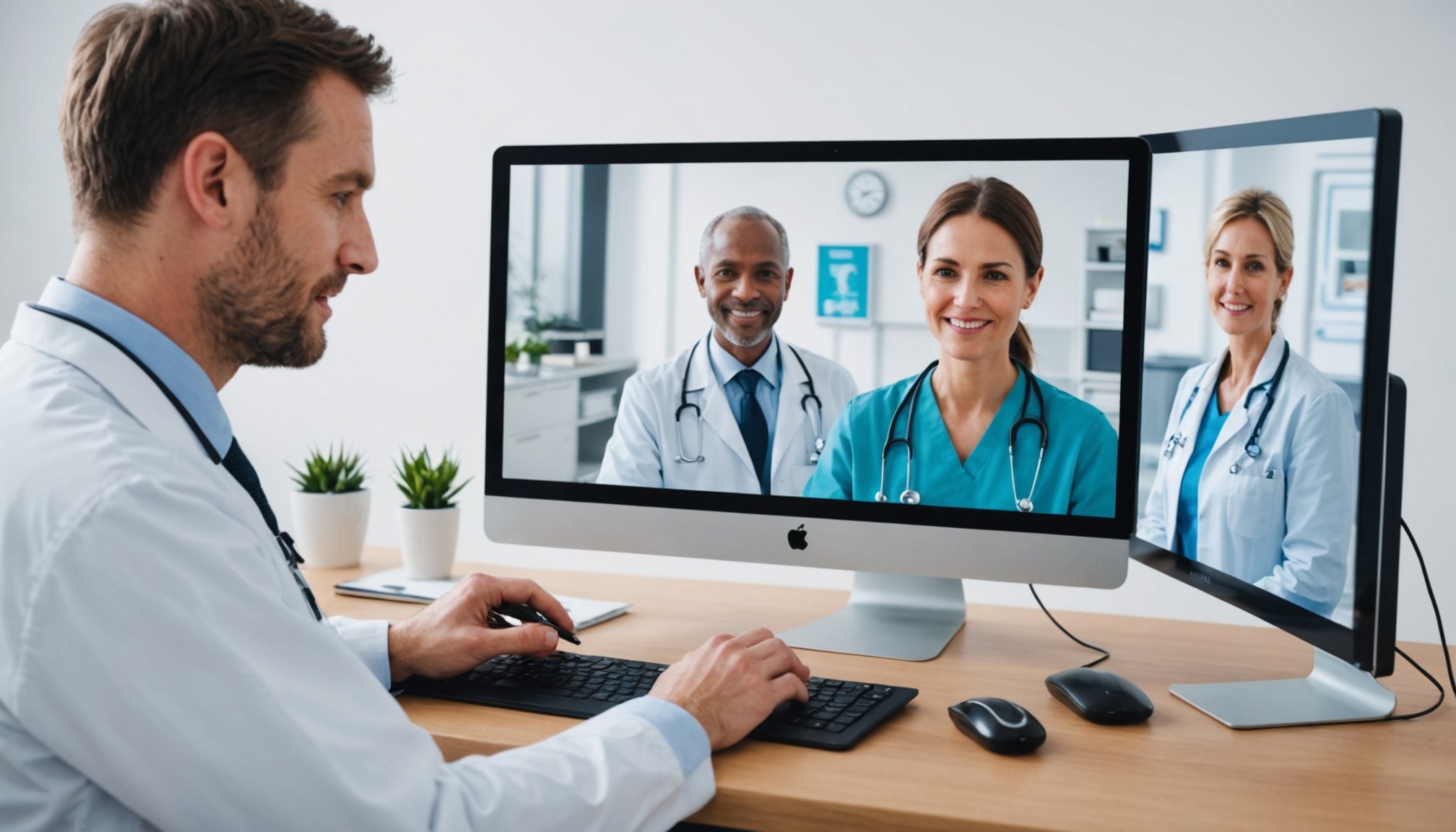Overview of Telemedicine in the UK
The evolution of telemedicine in the UK has transformed healthcare access, making it more accessible and efficient. Initially, telemedicine began as simple telephone consultations. However, advancements in technology have propelled it into a comprehensive digital healthcare system. Modern telemedicine leverages virtual communication tools and sophisticated gadgetry to provide real-time patient care, evolving beyond initial limitations.
In recent years, telemedicine has experienced a significant surge in growth within the UK. Studies have shown an increase in teleconference appointments by nearly 300% in some regions. This trend was notably accelerated by the COVID-19 pandemic, which necessitated remote healthcare solutions. Consequently, telemedicine has become a focal point of UK healthcare innovations.
In parallel : Effortless solutions: automate your collection processes today
Key technologies in telemedicine include secure video conferencing platforms and electronic health records, which ensure seamless healthcare service delivery. Wearable devices also play a vital role in monitoring patients’ health remotely. Artificial Intelligence is being utilised to enhance diagnostic processes, providing medical professionals with greater insights and resources. As the UK continues to pioneer telemedicine, these technologies will remain integral to healthcare access and improvement.
Innovative Telemedicine Approaches
The evolution of telehealth solutions continues to reshape the healthcare landscape, placing a strong emphasis on patient-centric care. Innovative approaches in telemedicine focus on enhancing both technology and accessibility to improve healthcare experiences.
Topic to read : Unlock Investment Potential: Leveraging Behavioral Finance for Smart Decision-Making by UK Investors
Remote Consultation Technologies
Advancements in video conferencing systems have enabled more seamless and effective remote consultations. These technologies facilitate real-time interactions, ensuring patients receive timely medical attention. AI and chatbots play a crucial role by providing preliminary assessments and directing patients to appropriate care paths, streamlining remote healthcare processes.
Mobile Health Applications
Mobile health applications have surged in popularity, offering users convenient access to various healthcare services. These apps support functions like booking appointments, tracking health metrics, and accessing medical records. They significantly enhance user experience and accessibility, making healthcare more personal and immediate.
Integrated Telehealth Platforms
Integrated telehealth platforms consolidate various services, creating a robust infrastructure for delivering comprehensive care. These platforms combine remote consultation, record management, and follow-up care, ensuring a cohesive healthcare journey. They leverage AI to personalise patient interactions, further enhancing the quality of care provided. The future of telemedicine looks bright as these innovative strategies revolutionise how healthcare is delivered and experienced.
Benefits of Telemedicine for Patients and Providers
Telemedicine offers a multitude of benefits for both patients and providers, revolutionising healthcare delivery. Firstly, it enhances healthcare access, particularly for individuals in rural or remote areas. Patients who would otherwise face long distances to healthcare facilities can access care conveniently through digital platforms. This advancement ensures they receive timely medical attention, thus improving overall patient outcomes.
In terms of patient engagement, telemedicine fosters a more interactive and personalised healthcare experience. Video consultations and mobile health apps engage patients actively in their care, promoting better adherence to treatment plans and increasing satisfaction. The virtual environment allows for more frequent check-ins, which helps in maintaining ongoing patient-healthcare provider relationships.
Cost-effectiveness is another significant advantage of telemedicine. Both patients and healthcare providers can benefit from reduced travel costs and more efficient resource allocation. Providers can optimise their schedules, reducing overhead while still delivering quality care. Patients save time and expenses related to travel, and potentially lower healthcare costs through reduced hospitalizations and emergency visits.
The profound impact of telemedicine is apparent in its ability to break traditional barriers, making healthcare more inclusive and efficient for everyone involved. This shift represents a fundamental transformation in healthcare dynamics within and beyond the UK.
Case Studies of Successful Telemedicine Integration
Gain insights from the success stories of telemedicine across various medical disciplines. These case studies not only highlight best practices but also underscore the transformative impact of telemedicine in real-world scenarios.
Primary Care Case Study
In primary care, the integration of telemedicine has revolutionised patient interactions. A notable case involves a GP practice adopting a telehealth platform to offer round-the-clock consultations. This adoption led to a 40% increase in patient engagement and satisfaction. Patients reported enhanced convenience and communication with their healthcare providers, illustrating the effectiveness of telemedicine in primary care environments.
Specialist Consultation Case Study
Another inspiring example is the deployment of telemedicine for specialist consultations. A study showed significant improvements in dermatology services with remote video consultations, reducing the waiting period from months to weeks. This case demonstrates how telehealth can expedite specialist appointments, offering timely and efficient medical advice.
Emergency Response Case Study
Telemedicine in emergency healthcare settings is a game-changer. A successful implementation in a UK ambulance service enabled paramedics to access specialist support via video links, contributing to informed decision-making in critical situations. This approach not only optimised emergency responses but also enhanced patient outcomes, highlighting the potential of telemedicine in life-saving scenarios.
Regulatory Framework and Challenges
Navigating the regulatory framework in UK telemedicine is essential for ensuring compliance and upholding patient privacy. The Health and Social Care Act provides guidelines to maintain quality and safety standards. Healthcare providers must adhere to these regulations to deliver secure telemedicine services.
Data protection is a significant concern, with the General Data Protection Regulation (GDPR) outlining strict rules about handling patient information. Ensuring robust cybersecurity measures is paramount to protect patient confidentiality and trust. Telemedicine platforms often incorporate advanced encryption techniques to safeguard data during virtual consultations.
Practitioners face various challenges within this evolving landscape. Ensuring equitable access across diverse populations, particularly those with limited digital literacy, remains a hurdle. Moreover, technical difficulties can impede service delivery, requiring ongoing investment in technology and staff training.
Compliance issues also pertain to the alignment of telemedicine practices with clinical standards. Practitioners must be mindful of maintaining the same level of care quality as traditional consultations. Regular audits and updates to protocols can support compliance, fostering trust and confidence in telehealth services.
By understanding these regulatory challenges, healthcare providers can optimise telemedicine solutions, contributing to a more reliable and secure healthcare system tailored to patients’ needs.
Expert Opinions and Patient Testimonials
Gaining insights from both healthcare professionals and patients provides a comprehensive view of telemedicine’s effectiveness. Experts in the field highlight telemedicine as a transformative force, stressing its role in enhancing accessibility and operational efficiency. They point out that AI integration in telehealth solutions has led to more precise diagnostics and personalised care, bridging gaps in traditional healthcare systems.
Patients, on the other hand, frequently express satisfaction with the convenience and immediacy telemedicine offers. Many testimonials reveal positive experiences with accessing medical consultations from the comfort of their homes, notably reducing travel and waiting times. This ease of access translates into better adherence to appointment schedules and medication plans, fostering continuous care and improved health outcomes.
A comparison between telemedicine and traditional healthcare shows mixed preferences. Some patients prefer the tangible assurance of in-person consultations, while others value the freedom and flexibility of remote care. Professionals emphasise the importance of maintaining high care standards, whether virtual or physical. This symbiosis between expert insights and patient feedback underscores the growing acceptance and integration of telemedicine within the broader healthcare landscape.
Statistics and Impact on Healthcare Delivery
Delving into telemedicine statistics reveals substantial insights into its broad effect on healthcare delivery, particularly in the UK. Since the onset of the COVID-19 pandemic, the adoption rates of telemedicine services have surged, marking a significant shift in healthcare dynamics. In fact, utilization rates increased remarkably, with some areas experiencing a 300% rise in teleconsultations.
Utilization Rates and Trends
Before the pandemic, telemedicine was steadily gaining traction, but the necessity for remote healthcare solutions during lockdowns catalysed its growth. This heightened adoption showcases a robust trend towards virtual healthcare services, facilitating continuity of care even amidst physical distancing measures.
Patient Satisfaction Metrics
Patient satisfaction remains integral to telemedicine’s success. Surveys and studies highlight that patients appreciate the convenience and immediacy of remote consultations, which minimize the need for travel and reduce wait times. This positive feedback underlines telemedicine’s critical role in enhancing patient experience and adherence to treatment plans.
Cost Savings Analysis
From a financial perspective, telemedicine presents promising avenues for cost reduction. Healthcare systems can save on infrastructure costs, while patients benefit from lower travel expenses and potentially reduced overall healthcare costs through preventive measures and fewer hospital visits, amplifying efficient resource utilisation and contributing to sustainable healthcare delivery.
Future Trends in Telemedicine
In the ever-evolving landscape of healthcare, the future of telemedicine holds promise with upcoming innovation trends that will drive healthcare evolution. As technology advances, emerging technologies will play a crucial role in redefining telehealth services, making them more interactive and efficient.
Emerging Technologies
Artificial Intelligence (AI) continues to revolutionise telemedicine by enabling more precise diagnostics and decision support. AI algorithms can analyse large datasets swiftly, leading to real-time insights that enhance patient care. Coupled with Virtual Reality (VR), telemedicine is set to provide immersive experiences for patient education and therapy sessions. Simultaneously, the Internet of Things (IoT) facilitates continuous health monitoring through connected devices, allowing healthcare practitioners to track patients’ well-being consistently.
Policy Developments
As telemedicine expands, policy developments will be critical in shaping its trajectory. Anticipated changes in regulation will ensure that telemedicine practices align with healthcare evolution standards, addressing security and ethical concerns. Legislators are expected to focus on enhancing cross-border telehealth services, enabling seamless care beyond geographical boundaries.
Predictions for Telemedicine Growth
Forecasts suggest a continued expansion of telemedicine services over the next decade, driven by healthcare innovation trends. As more facilities integrate these technologies, accessibility and quality of care will dramatically improve, significantly impacting the global healthcare landscape.











